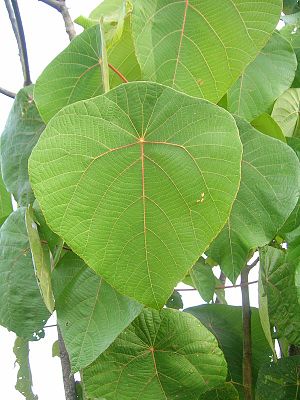Note: This is a project under development. The articles on this wiki are just being initiated and broadly incomplete. You can Help creating new pages.
Macaranga peltata - Uppalige
Uppalige is a very common tree in the evergreen and semi-evergreen forests of the western ghats. They are fast growing trees with large heart shaped leaves. One of the first trees to come up on roadsides and forest clearings.
Uses
Parts Used
Chemical Composition
It is also useful in coffee plantations for shade. The leaves are rich in nitrogen and potash. They contain water, 60.17; N, 1.3; potassium (KzO), 0.66; and phosphorus (PzOs), 0.18%6. [2]
Common names
| Language | Common name |
|---|---|
| Kannada | Batla chandrike, Chaandoda, Chanda kanne |
| Hindi | |
| Malayalam | Uppila, Vatta |
| Tamil | Vattakanni, Attattamarai |
| Telugu | Boddi, Godugu ganapa, Konda thaamara, Kondajaaphara, Pulichinjalamu |
| Marathi | NA |
| Gujarathi | NA |
| Punjabi | NA |
| Kashmiri | NA |
| Sanskrit | |
| English |
Properties
Reference: Dravya - Substance, Rasa - Taste, Guna - Qualities, Veerya - Potency, Vipaka - Post-digesion effect, Karma - Pharmacological activity, Prabhava - Therepeutics.
Dravya
Rasa
Vipaka
Karma
Prabhava
Habit
Identification
Leaf
| Kind | Shape | Feature |
|---|---|---|
| Simple | Alternate | Leaves simple, alternate, 11-25 x 9-20 cm, ovate-orbicular, deltoid-ovate, ovate or orbicular, apex acute or acuminate, base peltate, margin entire, glabrous or glabrescent, pubescent with reddish glands beneath, coriaceous; stipules large, lateral, ovate-acuminate, reflexed, cauducous; petiole 12-35 mm long, stout, glabrous; lamina 8-10 ribs from base, palmate, prominent beneath; lateral nerves 7-8 pairs, parallel, regular, prominent, intercostae scalariform, much prominent; margin glandular. |
Flower
| Type | Size | Color and composition | Stamen | More information |
|---|---|---|---|---|
| Unisexual | Male flowers: in axillary, much branched, dense, tomentose, panicles, concealed in large bracts; bracteoles concave; tepals 3, minute, obovate, cuneate; stamens 2-8, free, shortly connate below, exserted. Female flowers: in panicles simpler than in males, branches racemes with larger bracts; tepals 4, basally connate at base; ovary superior, 2-6-celled, densely glandular, ovule one in each cell; style lateral; stigma sessile, often embracing one side of the ovary, thickly papillose. | {{{3}}} | {{{4}}} | {{{5}}} |
Fruit
| Type | Size | Mass | Appearance | Seeds | More information |
|---|---|---|---|---|---|
| Capsule | 5-6 mm across | Globose, hairy, glandular, black; seed one, black. | {{{5}}} | {{{6}}} |
Other features
List of Ayurvedic medicine in which the herb is used
Where to get the saplings
Mode of Propagation
How to plant/cultivate
Trees produce an abundance of seeds. They need to be scarified before sowing, acid treatment or mechanical scarification can done. [5]
Commonly seen growing in areas
Photo Gallery
References
External Links
- Ayurvedic Herbs known to be helpful to treat Treat stomach-ache
- Ayurvedic Herbs known to be helpful to treat Dysentery
- Ayurvedic Herbs known to be helpful to treat Haemoptysis
- Ayurvedic Herbs known to be helpful to treat Cough
- Ayurvedic Herbs known to be helpful to treat Fever
- Ayurvedic Herbs known to be helpful to treat Dysuria
- Ayurvedic Herbs known to be helpful to treat Skin problems
- Herbs with Roots used in medicine
- Herbs with Leaves used in medicine
- Herbs with Bark used in medicine
- Herbs with common name in Kannada
- Herbs with common name in Malayalam
- Herbs with common name in Tamil
- Herbs with common name in Telugu
- Habit - Tree
- Index of Plants which can be propagated by Seeds
- Herbs that are commonly seen in the region of Tropical area
- Herbs that are commonly seen in the region of Evergreen forest
- Herbs that are commonly seen in the region of Moist deciduous forest
- Herbs
- Plants of western ghats
- Euphorbiaceae






